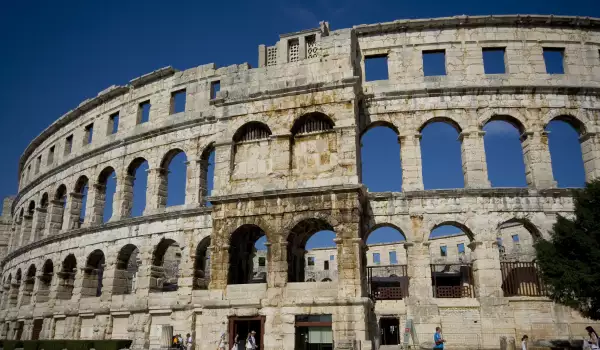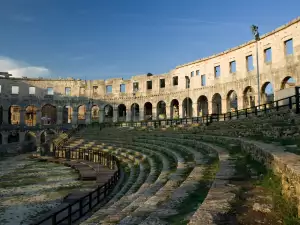Coliseum of Pula - Pula Arena

Coliseum of Pula is the little brother of the Coliseum in Rome. This extremely ancient structure has been preserved in very good condition, and is one of pride of the city Pula. This Croatian town is the largest in Istria. It has about 60, 000 residents, a major port and airport. Pula was formed inside the bay, which is divided into three pools of the islands: Saint Catherine, Saint Andrew and Yulyanik. Beautiful Pula is considered the best-protected natural bay on the Adriatic.
The history of Pula starts from Roman times. Then, the village is built on seven hills, like ancient Rome. Realistically, however, Pula is there more than 3 millennia, and its establishment is linked to the legend of the Argonauts, and the Golden Fleece. Even today in Pula remain valuable architectural monuments, built centuries ago.
Undoubtedly, the largest historic landmark Pula is The Coliseum. An arena, which was used for gladiatorial combat. The Coliseum of Pula, was built during the reign of Emperor Vespasian and even then people called it "the little brother of the Coliseum in Rome”.
Coliseum of Pula was built in 27 BC to 68 years after AD, Today the arena is among the six largest surviving Roman arenas in the world, and a rare example of technological solutions among 200 Roman amphitheatres, in the world, survived until today. Coliseum of Pula is so well preserved, as its walls are still almost complete, that the monument is considered the best preserved ancient monument in the whole of Croatia.

This ancient Roman arena holds about 23, 000 people. The wall seaward reaches 34 meters at its widest diameter is a hole 135 meters. 72 arches can be seen that managed to keep rain and storms out in the past 2000 years. At about 404 years, gladiatorial games were banned, then the Coliseum of Pula was used as a market.
Over the centuries, Venetians used the dominant design arena as a source of building materials for their houses. Today, at the Coliseum of Pula no longer are held gladiator fights, but mostly shows, film festivals, theater, opera performances and pop-rock concerts. The Coliseum of Pula hosted even Sting, sung here Luciano Pavarotti, Jose Carreras, Eros Ramazzotti and many others.
Among other attractions in Pula are the ruins of the Roman Forum, Arc de Triomphe of Sirius, the door of Hercules, the Temple of Augustus, Byzantine mausoleum of 6 century, medieval Romanesque and Gothic Churches and the Venetian fortress.















